Monday, May 31st 2021

AMD Announces FidelityFX Super Resolution (FSR), its DLSS-rival
AMD finally made a big announcement on its ambitious FidelityFX Super Resolution (FSR) technology, the company's rival to NVIDIA's popular DLSS. Much like it, FSR aims to significantly improve gaming performance with minimal loss in image quality, through a sophisticated supersampling algorithm. At this point, AMD did not detail the nuts and bolts of the feature, but mentioned how the feature could look to gamers.
There are four FSR presets typically available to a supported game—Ultra Quality, Quality, Balanced, and Performance, which AMD claims offer performance gains of 59% for "Ultra Quality," 102% for "Quality," 153% for "Balanced," and 206% for "Performance." These should come particularly handy when playing games with raytracing on; and were measured on "Godfall" with RX 6800 XT, with 4K "epic" preset, and raytracing enabled. As of now, the company is working with over 10 game studios and game engine developers to integrate FSR, and the technology is expected to support "over 100 CPUs and GPUs."Update Jun 22nd: We have now posted our in-depth review of AMD Radeon FidelityFX Super Resolution (FSR).
The FSR slide-deck follows.
There are four FSR presets typically available to a supported game—Ultra Quality, Quality, Balanced, and Performance, which AMD claims offer performance gains of 59% for "Ultra Quality," 102% for "Quality," 153% for "Balanced," and 206% for "Performance." These should come particularly handy when playing games with raytracing on; and were measured on "Godfall" with RX 6800 XT, with 4K "epic" preset, and raytracing enabled. As of now, the company is working with over 10 game studios and game engine developers to integrate FSR, and the technology is expected to support "over 100 CPUs and GPUs."Update Jun 22nd: We have now posted our in-depth review of AMD Radeon FidelityFX Super Resolution (FSR).
The FSR slide-deck follows.

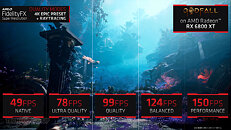

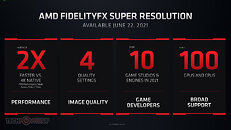
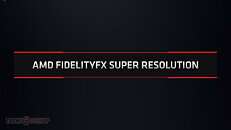
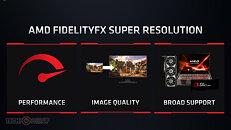
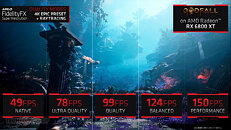



106 Comments on AMD Announces FidelityFX Super Resolution (FSR), its DLSS-rival
and CPU's... is it because some AMD APU's will support it? or is it run (even in part) on the CPU, so only certain ones/above a certain threshold of cores/speed etc will support it?
I am really interested to understand what is going on under the hood.
The same way DLSS is far less impressive when running on 1440p with "Performance" mode when compared to 4K in "Quality" mode.
And as always it's best to wait for independent testing. Hope AMD provides early access to testers before the June 22 release date.
that being said, I still think it's amazing AMD can compete with a 3080 at the $649 price range in the year 2020... with solid stable drivers. to be honest you got to give them credit for that, their gpu division almost died after the 5700 driver issue drama. I actually tried to get a 3080 on launch day but failed. that was only reason i got the 6800. and i have been pleasantly surprised how stable its been. and how many frames it gives me. etcya I'm not tossing it out or anything, just not hopeful. will be interesting to see reviews June 22nd, not far away now.
your logic is failing here. if it was a mistake then it was, but I highly doubt AMD would have given less than 100% effort in showcasing their much debated and talked about FSR/DLSS software. they knew the community was excited for it. they wouldn't have half assed their presentation. again it may have been a mistake in which case you may be right... we will know June 22nd when more reviews come out.
Thank You
I'm sure someone will come along and correct me if I'm wrong, but I do believe APU's were mentioned as being supported in the presentation.
Best,
Liquid Cool
This being said, its important to note that AMD’s solution isn’t AI, and isn’t Temporal, its Spatial. Upside, there’s no frame delay so image persistence should be excellent. Downside, spatial upsampling usually doesn’t accumulate frame date (unless the algorithm is adaptive), so image quality is likely to be lower. The effect of this can be seen in DLSS in when you update the entire image (by spinning) and when you stop there being a momentary ‘snap’ to full quality as DLSS accumulates previous frame data.
FSR being available everywhere is likely the biggest thing that will kill DLSS off however, no need to spend time integrating one technology for one platform when you can build and ship once.
Would be pretty funny if FSR can be applied on top of DLSS, DLSS Quality + FSR Ultra Quality for some insane visual/performance uplift LOL.
This is a huge win for all gamers, having options that let us get away with weaker hardware
1\ Most widely implemented for targets across multiple platforms (think Speedtree, Havoc, and some aspects of Gameworks).
2\ Available by default (think UE extensions)
3\ Paid to implement.
The 'quality' of the solution is oddly enough, not usually the deciding factor.
If Nvidia can reduce the burden on devs to almost nothing, we may see it on PC ports, but that will limit it to Unreal Engine titles almost exclusively (as don't expect large publishing houses to maintain branch compatibility specifically for PC when cross target alternatives exist).
If FSR can't distinguish itself IQ wise from just simple upscaling + CAS (which DLSS 2.0 already proved itself) then FSR will probably join Radeon Boost into oblivion.
But you are delusional that devs will spend the hours to implement a one vendor only for one platform upscaling tech if something close enough is available that supports all of their targets unless they are being paid to implement it or its literally a tickbox.
First, let's get a larger sample size.
Second, afford AMD the same Nvidia was afforded. Don't be a hypocrite.